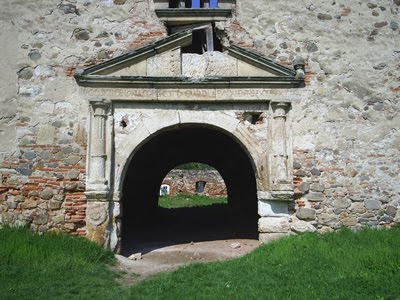Medieşu Aurit (Hungarian: Aranyosmeggyes) is a commune of 7,299 residents in Satu Mare County.
The Lonyai Castle was built between 1620-1657, by Zsigmond Lonyai, in the purest Renaissance style. Similar castles can be found only in Slovakia. The building consists of four wings arranged around a central courtyard, with bastions at the four corners and a tower above the main entrance; the strongholds are Italian type. Elements of fortification as a ditch and a drawbridge are still visible.
The blank arcades under the roof of the tower suggest that there was originally cresting here too. The facade and the details of the castle are severe, with strong architectonic details and pedimented windows of the type that Italian architect Giacomo Resti introduced in other castles.
Servants' rooms, the kitchen and stores were on the ground floor while the first floor was for the landowners. Window frames were decorated with leaves and vines. At the entrance castle was the Lonyai family coat of arms, stolen after the Revolution of 1989. The first floor ceiling was covered with gold, so the name of place became Medieşu Aurit (Golden Medieşu).
After the death of Zsigmond Lonyai, the owner of the castle was his daughter, Anna. She became involved in an action of the "curuţi" rebels in the area, which attacked the German garrison in the city of Satu-Mare. After that, all domain comes in Royal administration. Later, the castle was bought by the family Wesselenyi, then inherited by the Teleki family, and King Carol II of Romania bought in 1920 the castle.
In 1944, the castle was used as a military hospital, and was burned and became a ruin during the retreat of the German Army. Later, locals have demolished the walls and have built houses from castle's bricks. Basically, today there are only a few walls and frames of windows and doors, which are decaying quickly.
Piata Postei
2 days ago








0 comments:
Post a Comment